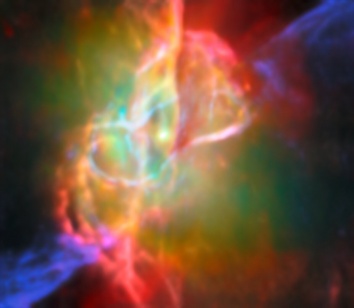The Butterfly Nebula, located about 3,400 light-years away in the constellation Scorpius, is one of the best-studied planetary nebulae in our galaxy.
“The first sensitive optical images of this nebula were obtained by David S. Evans, an astronomy professor from 1968-1986 at The University of Texas at Austin,” said Harriet Dinerstein, currently a professor at UT Austin. She was inspired by Evans’ images to study the nebula with her husband, Dan Lester, also a UT astronomer, in the mid-1980s. “Using the primitive instrumentation available at the time, we found intense infrared emission from a flattened structure in the center of the nebula, but not its full complexity.”
Now a large international team of astronomers including Dinerstein have captured a new view of the Butterfly Nebula using the Webb telescope.
Planetary nebulae are among the most beautiful and most elusive creatures in the cosmic zoo. These nebulae form when stars with masses between about 0.8 and 8 times the mass of the Sun shed most of their mass at the end of their lives. The planetary nebula phase is fleeting, lasting only about 20,000 years.
Contrary to the name, planetary nebulae have nothing to do with planets: the naming confusion began several hundred years ago, when astronomers reported that these nebulae appeared round, like planets. The name stuck, even though many planetary nebulae aren’t round at all — and the Butterfly Nebula is a prime example of the fantastic shapes that these nebulae can take.
The Butterfly Nebula is a bipolar nebula, meaning that it has two lobes that spread in opposite directions, forming the ‘wings’ of the butterfly separated by narrow, pinched ‘waist.’” The Butterfly is a standout among bipolar nebulae, in that it shows a narrow linear dark lane between its wings, appearing to be the butterfly’s body. “Such dark lanes are common in giant interstellar clouds where stars are forming,” said Dinerstein. “But the Butterfly Nebula is unique as a planetary nebula containing one.”
The band is actually a doughnut-shaped torus that’s being viewed from the side, hiding the nebula’s central star — the ancient core of a star with a mass about five times that of the Sun that energizes the nebula and causes it to glow. The dusty doughnut may be responsible for the nebula’s insectoid shape by preventing gas from flowing outward from the star equally in all directions. This new image zooms in on the center of the Butterfly Nebula and its dusty torus, providing an unprecedented view of its complex structure.
Researchers analyzing Webb data identified nearly 200 spectral lines, each of which holds information about the atoms and molecules in the nebula. These lines reveal nested and interconnected structures traced by different chemical species.
The team has also pinpointed the location of the Butterfly Nebula’s central star. Though they cannot observe the star directly, they were able to detect the dust cloud surrounding it. The location of the nebula’s central star has remained elusive until now, because this enshrouding dust renders it invisible at optical and short infrared wavelengths. Previous searches for the star lacked Webb’s combination of infrared sensitivity and resolution necessary to spot its obscuring warm dust cloud. With a temperature of nearly 400,000 Fahrenheit, this is one of the hottest known central stars in a planetary nebula in our galaxy.
This blazing stellar engine is responsible for the nebula’s gorgeous glow, but its full power may be channeled by the dense band of dusty gas that surrounds it: the torus. The torus is composed of crystalline silicates like quartz as well as irregularly shaped dust grains. The dust grains have sizes on the order of a millionth of a meter — large, as far as cosmic dust is considered — indicating that they have been growing for a long time.
Outside the torus, the emission from different atoms and molecules takes on a multilayered structure. The ions that require the largest amount of energy to form are concentrated close to the center, while those that require less energy are found farther from the central star. Iron and nickel are particularly interesting, tracing a pair of jets that blast outward from the star in opposite directions.
“These observations have provided new insights into this remarkable nebula,” said Dinerstein. “Yet many mysteries remain. We have yet to fully reconstruct the tangled structure and history of the star responsible for creating and lighting up the nebula. I look forward to continuing to research this extraordinary object.”
The results were published August 27 in Monthly Notices of the Royal Astronomical Society. Supplemental observations were provided by the Atacama Large Millimeter/submillimeter Array.
Adapted from a press release by the European Space Agency.







